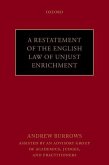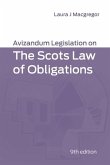Emmanuel Voyiakis
Private Law and the Value of Choice
Emmanuel Voyiakis
Private Law and the Value of Choice
- Gebundenes Buch
- Merkliste
- Auf die Merkliste
- Bewerten Bewerten
- Teilen
- Produkt teilen
- Produkterinnerung
- Produkterinnerung
Voyiakis argues that private law aims to articulate acceptable principles as to when our institutions can hold agents accountable for their choices.
Andere Kunden interessierten sich auch für
![New Directions in Private Law Theory New Directions in Private Law Theory]() New Directions in Private Law Theory31,99 €
New Directions in Private Law Theory31,99 €![Horizontal Rights Horizontal Rights]() Dr Gautam Bhatia (Germany Freie University Berlin)Horizontal Rights110,99 €
Dr Gautam Bhatia (Germany Freie University Berlin)Horizontal Rights110,99 €![The Cambridge Handbook of Private Law and Artificial Intelligence The Cambridge Handbook of Private Law and Artificial Intelligence]() The Cambridge Handbook of Private Law and Artificial Intelligence190,99 €
The Cambridge Handbook of Private Law and Artificial Intelligence190,99 €![Hannah Arendt and the Law Hannah Arendt and the Law]() Hannah Arendt and the Law45,99 €
Hannah Arendt and the Law45,99 €![A Restatement of the English Law of Unjust Enrichment A Restatement of the English Law of Unjust Enrichment]() QC Burrows FBA (hon) Andrew (Oxfo Professor of the Law of EnglandA Restatement of the English Law of Unjust Enrichment78,99 €
QC Burrows FBA (hon) Andrew (Oxfo Professor of the Law of EnglandA Restatement of the English Law of Unjust Enrichment78,99 €![New Perspectives on the Public-Private Divide New Perspectives on the Public-Private Divide]() Law Commission of CanadaNew Perspectives on the Public-Private Divide121,99 €
Law Commission of CanadaNew Perspectives on the Public-Private Divide121,99 €![Avizandum Legislation on the Scots Law of Obligations Avizandum Legislation on the Scots Law of Obligations]() Avizandum Legislation on the Scots Law of Obligations40,99 €
Avizandum Legislation on the Scots Law of Obligations40,99 €-
-
-
Voyiakis argues that private law aims to articulate acceptable principles as to when our institutions can hold agents accountable for their choices.
Produktdetails
- Produktdetails
- Law and Practical Reason
- Verlag: Bloomsbury Publishing PLC
- Seitenzahl: 268
- Erscheinungstermin: 12. Januar 2017
- Englisch
- Abmessung: 240mm x 161mm x 19mm
- Gewicht: 536g
- ISBN-13: 9781841138862
- ISBN-10: 184113886X
- Artikelnr.: 30165086
- Herstellerkennzeichnung
- Libri GmbH
- Europaallee 1
- 36244 Bad Hersfeld
- gpsr@libri.de
- Law and Practical Reason
- Verlag: Bloomsbury Publishing PLC
- Seitenzahl: 268
- Erscheinungstermin: 12. Januar 2017
- Englisch
- Abmessung: 240mm x 161mm x 19mm
- Gewicht: 536g
- ISBN-13: 9781841138862
- ISBN-10: 184113886X
- Artikelnr.: 30165086
- Herstellerkennzeichnung
- Libri GmbH
- Europaallee 1
- 36244 Bad Hersfeld
- gpsr@libri.de
Emmanuel Voyiakis is an associate professor at the LSE Law Department.
1. Private Law and the Burden of Repair
I. Original Burdens and Burdens of Repair
II. A 'Direct' Account of the Burden of Repair
III. The Significance of Wrongfulness
IV. Repair Without Wrongfulness or Corrective Justice
2. Responsibility, but the Right Kind
I. Substantive and Attributive Responsibility
II. Private Law Principles as Allocations of Substantive Responsibilities
III. Some Implications of the Attributive/Substantive Divide
IV. A Progress Report
3. Choice and Responsibility
I. The Value of Choice and the Asymmetry between Benefits and Burdens
II. Making a Choice vs having a Choice
III. Two Sets of Objections
IV. From the Value-of-choice Account to Models of Private Law
4. Protection Against the Burden of Repair
I. Why Protection?
II. Protection as a 'Bail Out' and as a Condition of Responsibility
III. Protection as a Condition of Responsibility: A Preview
IV. Working Examples and Variations
V. The Protection Principle
VI. Comparing Notes: Other Accounts of Contributory Negligence
VII. Protection and the 'Background Conditions' of Choice
5. Avoidability
I. Exercise of Care as an Objection to Liability
II. Rylands v Fletcher and Doing Things on One's Own Terms
III. Limited Capacities and the Standard of Care
IV. Negligence Liability and the UK SARAH Act 2015
V. Conclusion
6. Contracts and the Social Structure
I. The Classical Story and Its Limitations: Scanlon's EL and EF Principles
II. A Structure-sensitive Alternative: The EFS Principle
III. Three Objections
IV. Contract Doctrine in the Light of the EFS Principle
V. 'Fair Terms', Justice, and Opportunity
7. Vicarious Liability
I. Participation and Placement
II. The Significance of Placement
III. Participation and Attribution
IV. An Illustration: Vicarious Liability for the Use of Cars
V. Vicarious Liability as Protection
VI. Liability for Protection vs Direct Liability
VII. Conclusion
I. Original Burdens and Burdens of Repair
II. A 'Direct' Account of the Burden of Repair
III. The Significance of Wrongfulness
IV. Repair Without Wrongfulness or Corrective Justice
2. Responsibility, but the Right Kind
I. Substantive and Attributive Responsibility
II. Private Law Principles as Allocations of Substantive Responsibilities
III. Some Implications of the Attributive/Substantive Divide
IV. A Progress Report
3. Choice and Responsibility
I. The Value of Choice and the Asymmetry between Benefits and Burdens
II. Making a Choice vs having a Choice
III. Two Sets of Objections
IV. From the Value-of-choice Account to Models of Private Law
4. Protection Against the Burden of Repair
I. Why Protection?
II. Protection as a 'Bail Out' and as a Condition of Responsibility
III. Protection as a Condition of Responsibility: A Preview
IV. Working Examples and Variations
V. The Protection Principle
VI. Comparing Notes: Other Accounts of Contributory Negligence
VII. Protection and the 'Background Conditions' of Choice
5. Avoidability
I. Exercise of Care as an Objection to Liability
II. Rylands v Fletcher and Doing Things on One's Own Terms
III. Limited Capacities and the Standard of Care
IV. Negligence Liability and the UK SARAH Act 2015
V. Conclusion
6. Contracts and the Social Structure
I. The Classical Story and Its Limitations: Scanlon's EL and EF Principles
II. A Structure-sensitive Alternative: The EFS Principle
III. Three Objections
IV. Contract Doctrine in the Light of the EFS Principle
V. 'Fair Terms', Justice, and Opportunity
7. Vicarious Liability
I. Participation and Placement
II. The Significance of Placement
III. Participation and Attribution
IV. An Illustration: Vicarious Liability for the Use of Cars
V. Vicarious Liability as Protection
VI. Liability for Protection vs Direct Liability
VII. Conclusion
1. Private Law and the Burden of Repair
I. Original Burdens and Burdens of Repair
II. A 'Direct' Account of the Burden of Repair
III. The Significance of Wrongfulness
IV. Repair Without Wrongfulness or Corrective Justice
2. Responsibility, but the Right Kind
I. Substantive and Attributive Responsibility
II. Private Law Principles as Allocations of Substantive Responsibilities
III. Some Implications of the Attributive/Substantive Divide
IV. A Progress Report
3. Choice and Responsibility
I. The Value of Choice and the Asymmetry between Benefits and Burdens
II. Making a Choice vs having a Choice
III. Two Sets of Objections
IV. From the Value-of-choice Account to Models of Private Law
4. Protection Against the Burden of Repair
I. Why Protection?
II. Protection as a 'Bail Out' and as a Condition of Responsibility
III. Protection as a Condition of Responsibility: A Preview
IV. Working Examples and Variations
V. The Protection Principle
VI. Comparing Notes: Other Accounts of Contributory Negligence
VII. Protection and the 'Background Conditions' of Choice
5. Avoidability
I. Exercise of Care as an Objection to Liability
II. Rylands v Fletcher and Doing Things on One's Own Terms
III. Limited Capacities and the Standard of Care
IV. Negligence Liability and the UK SARAH Act 2015
V. Conclusion
6. Contracts and the Social Structure
I. The Classical Story and Its Limitations: Scanlon's EL and EF Principles
II. A Structure-sensitive Alternative: The EFS Principle
III. Three Objections
IV. Contract Doctrine in the Light of the EFS Principle
V. 'Fair Terms', Justice, and Opportunity
7. Vicarious Liability
I. Participation and Placement
II. The Significance of Placement
III. Participation and Attribution
IV. An Illustration: Vicarious Liability for the Use of Cars
V. Vicarious Liability as Protection
VI. Liability for Protection vs Direct Liability
VII. Conclusion
I. Original Burdens and Burdens of Repair
II. A 'Direct' Account of the Burden of Repair
III. The Significance of Wrongfulness
IV. Repair Without Wrongfulness or Corrective Justice
2. Responsibility, but the Right Kind
I. Substantive and Attributive Responsibility
II. Private Law Principles as Allocations of Substantive Responsibilities
III. Some Implications of the Attributive/Substantive Divide
IV. A Progress Report
3. Choice and Responsibility
I. The Value of Choice and the Asymmetry between Benefits and Burdens
II. Making a Choice vs having a Choice
III. Two Sets of Objections
IV. From the Value-of-choice Account to Models of Private Law
4. Protection Against the Burden of Repair
I. Why Protection?
II. Protection as a 'Bail Out' and as a Condition of Responsibility
III. Protection as a Condition of Responsibility: A Preview
IV. Working Examples and Variations
V. The Protection Principle
VI. Comparing Notes: Other Accounts of Contributory Negligence
VII. Protection and the 'Background Conditions' of Choice
5. Avoidability
I. Exercise of Care as an Objection to Liability
II. Rylands v Fletcher and Doing Things on One's Own Terms
III. Limited Capacities and the Standard of Care
IV. Negligence Liability and the UK SARAH Act 2015
V. Conclusion
6. Contracts and the Social Structure
I. The Classical Story and Its Limitations: Scanlon's EL and EF Principles
II. A Structure-sensitive Alternative: The EFS Principle
III. Three Objections
IV. Contract Doctrine in the Light of the EFS Principle
V. 'Fair Terms', Justice, and Opportunity
7. Vicarious Liability
I. Participation and Placement
II. The Significance of Placement
III. Participation and Attribution
IV. An Illustration: Vicarious Liability for the Use of Cars
V. Vicarious Liability as Protection
VI. Liability for Protection vs Direct Liability
VII. Conclusion









